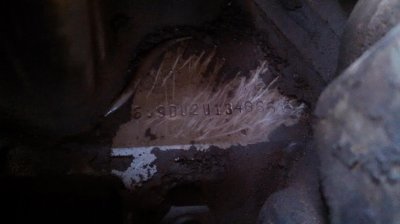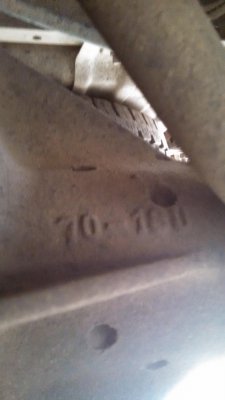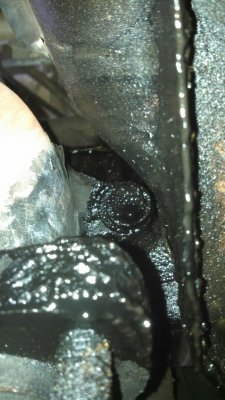You are using an out of date browser. It may not display this or other websites correctly.
You should upgrade or use an alternative browser.
You should upgrade or use an alternative browser.
figuring out my truck...
- Thread starter manimal
- Start date
sorry for the HUGE pics, im not sure why they are posting so big.
Waystro
No Class
First pic is the block number
Get a pic of the pumpkin
And last but not least it could be a valve cover leak. Need a better pic there also
There's my 2CW.
Get a pic of the pumpkin
And last but not least it could be a valve cover leak. Need a better pic there also
There's my 2CW.
Your camera should allow you to choose what size photo you can take. Try Small to start.
Dave
sometimes the site does it on its own.
i find that it happens when you go into "manage attachments" and delete attachments, but the post still has the code imbetted into it.
i have tried and not been able to figure out how to manipulate the code.
there either in the "album" perfect size, or too f'n big.
all pics from the same camera.
Waystro
No Class
Same thing happens to me guess it's just the nature of the beast. 

gandalf
Senior Member
You asked about early block serial numbers. I copied the following, somewhat lengthy, info from somewhere long forgotten. The interesting thing is that your block number seems a bit short. What appears to be a star at the end doesn't fit. Anyway, here is what I copied. Perhaps somebody could verify it's reliability.
*********************
CYLINDER BLOCKS
6.9L IDI 1983-1987
Starting at the beginning, the 6.9L IDI engine was introduced in 1983 with the first series block (c/n 1805440C1). This is considered by most as not a viable block casting for rebuilding. It is easily recognized by the lightweight or narrow gusseting across the upper area in the front of the block (Figure 1).
In 1984 the second series block (c/n 1807996C1) was introduced. With improved structural integrity, this is considered the block to use for all applications of 6.9L engines. To rapidly identify it, look at the same area in the front of the block (Figure 2) with the wide gusseting. The 6.9L was never turbocharged, therefore you will only require one long block part number for all 6.9L applications.
7.3L IDI 1988-1994
Block c/n 10809000C1 was used for the entire 7.3L IDI years of production. The serial numbers for naturally aspirated applications are 500,079 through 1,116,330.
This block was prone to cavitation damage on the exterior of the cylinder walls on the left bank thrust/valley side of the cylinders. For more details about cavitation see "Core Corner: Fighting Truth Decay About Cavitation" (Engine Builder, January 2006, page 38).
These walls were recorded as moving as much as .004˝. Since this block looks nearly identical to the 6.9L, the quick visual for identification are the coolant ports at the corners of the cylinder deck. The 6.9L has triangular coolant ports (Figure 3), while the 7.3L coolant ports are round (Figure 4).
7.3L IDIT 1992-1994
Block c/n 10809000C3 is the turbo block and the end of the IDI chapter. These engines carried serial numbers 1,116,331 to the end of production for the family. Note that the casting number is identical to the non-turbo block other than the C3 at the end. Make no mistake: this is a different and stronger block, which you may certainly use for IDI applications but do not attempt to do it the other way around. You will regret it.
One of the key differences is that the main webs on the turbo blocks are approximately .100˝ thicker. The visual aid for this block can be found at the rear of the engine. The turbo block has a 1/4˝ pipe threaded hole for the oil feed for the turbo (Figure 5). This same port on the non-turbo block is just 1/8˝ and is used for the oil pressure gauge. There are non-turbo blocks out in the field that have been drilled and tapped to 1/4˝ so it is always a good idea to verify serial and casting number.
Heres the link I got this info from http://www.enginebuildermag.com/Arti...ke_engine.aspx
*********************
CYLINDER BLOCKS
6.9L IDI 1983-1987
Starting at the beginning, the 6.9L IDI engine was introduced in 1983 with the first series block (c/n 1805440C1). This is considered by most as not a viable block casting for rebuilding. It is easily recognized by the lightweight or narrow gusseting across the upper area in the front of the block (Figure 1).
In 1984 the second series block (c/n 1807996C1) was introduced. With improved structural integrity, this is considered the block to use for all applications of 6.9L engines. To rapidly identify it, look at the same area in the front of the block (Figure 2) with the wide gusseting. The 6.9L was never turbocharged, therefore you will only require one long block part number for all 6.9L applications.
7.3L IDI 1988-1994
Block c/n 10809000C1 was used for the entire 7.3L IDI years of production. The serial numbers for naturally aspirated applications are 500,079 through 1,116,330.
This block was prone to cavitation damage on the exterior of the cylinder walls on the left bank thrust/valley side of the cylinders. For more details about cavitation see "Core Corner: Fighting Truth Decay About Cavitation" (Engine Builder, January 2006, page 38).
These walls were recorded as moving as much as .004˝. Since this block looks nearly identical to the 6.9L, the quick visual for identification are the coolant ports at the corners of the cylinder deck. The 6.9L has triangular coolant ports (Figure 3), while the 7.3L coolant ports are round (Figure 4).
7.3L IDIT 1992-1994
Block c/n 10809000C3 is the turbo block and the end of the IDI chapter. These engines carried serial numbers 1,116,331 to the end of production for the family. Note that the casting number is identical to the non-turbo block other than the C3 at the end. Make no mistake: this is a different and stronger block, which you may certainly use for IDI applications but do not attempt to do it the other way around. You will regret it.
One of the key differences is that the main webs on the turbo blocks are approximately .100˝ thicker. The visual aid for this block can be found at the rear of the engine. The turbo block has a 1/4˝ pipe threaded hole for the oil feed for the turbo (Figure 5). This same port on the non-turbo block is just 1/8˝ and is used for the oil pressure gauge. There are non-turbo blocks out in the field that have been drilled and tapped to 1/4˝ so it is always a good idea to verify serial and casting number.
Heres the link I got this info from http://www.enginebuildermag.com/Arti...ke_engine.aspx
If a picture is too big you can right click on it and select "view image" to see a smaller version. A lot of mine are in that category. I think my camera setting was too high.
I think the serial # has been altered. The 666 at the end don't look like the 6 in 6.9 at the beginning. They are out of line a bit also.
I think the serial # has been altered. The 666 at the end don't look like the 6 in 6.9 at the beginning. They are out of line a bit also.
The biggest thing I'm noticing is that the article's using International-Harvester part numbers, as opposed to block serial numbers. Here's the list of improvements made to the engines based on block serial numbers:You asked about early block serial numbers. I copied the following, somewhat lengthy, info from somewhere long forgotten. The interesting thing is that your block number seems a bit short. What appears to be a star at the end doesn't fit. Anyway, here is what I copied. Perhaps somebody could verify it's reliability.
*********************
CYLINDER BLOCKS
6.9L IDI 1983-1987
Starting at the beginning, the 6.9L IDI engine was introduced in 1983 with the first series block (c/n 1805440C1). This is considered by most as not a viable block casting for rebuilding. It is easily recognized by the lightweight or narrow gusseting across the upper area in the front of the block (Figure 1).
In 1984 the second series block (c/n 1807996C1) was introduced. With improved structural integrity, this is considered the block to use for all applications of 6.9L engines. To rapidly identify it, look at the same area in the front of the block (Figure 2) with the wide gusseting. The 6.9L was never turbocharged, therefore you will only require one long block part number for all 6.9L applications.
7.3L IDI 1988-1994
Block c/n 10809000C1 was used for the entire 7.3L IDI years of production. The serial numbers for naturally aspirated applications are 500,079 through 1,116,330.
This block was prone to cavitation damage on the exterior of the cylinder walls on the left bank thrust/valley side of the cylinders. For more details about cavitation see "Core Corner: Fighting Truth Decay About Cavitation" (Engine Builder, January 2006, page 38).
These walls were recorded as moving as much as .004˝. Since this block looks nearly identical to the 6.9L, the quick visual for identification are the coolant ports at the corners of the cylinder deck. The 6.9L has triangular coolant ports (Figure 3), while the 7.3L coolant ports are round (Figure 4).
7.3L IDIT 1992-1994
Block c/n 10809000C3 is the turbo block and the end of the IDI chapter. These engines carried serial numbers 1,116,331 to the end of production for the family. Note that the casting number is identical to the non-turbo block other than the C3 at the end. Make no mistake: this is a different and stronger block, which you may certainly use for IDI applications but do not attempt to do it the other way around. You will regret it.
One of the key differences is that the main webs on the turbo blocks are approximately .100˝ thicker. The visual aid for this block can be found at the rear of the engine. The turbo block has a 1/4˝ pipe threaded hole for the oil feed for the turbo (Figure 5). This same port on the non-turbo block is just 1/8˝ and is used for the oil pressure gauge. There are non-turbo blocks out in the field that have been drilled and tapped to 1/4˝ so it is always a good idea to verify serial and casting number.
Heres the link I got this info from http://www.enginebuildermag.com/Arti...ke_engine.aspx
You must be registered for see images attach
I'm not sure what the star is either, but for what it's worth, his block number is higher than mine (my engine block serial number is 6.9D U2U 048458, in a 1984 model year truck built in August '83)...shame it's still an early block.
crash-harris
Breaker! Breaker!
Yes, looks like it was hand stamped with a different set of stamps 

gandalf
Senior Member
Right. I go with the fact that the stamped numbers appear different. The "666" is not the same as what is in front of it. My best guess would be that that is a remanufactured engine, and the rebuilder changed the number and added a star for identification purposes. Look closely to see whether the area around the "666" appears to be ground out.
crash-harris
Breaker! Breaker!
Or just a young, excited previous owner 

Similar threads
- Replies
- 11
- Views
- 575
- Replies
- 13
- Views
- 1K



